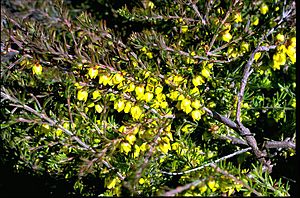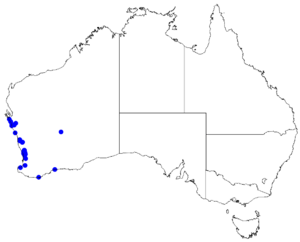Boronia purdieana facts for kids
Quick facts for kids Winter boronia |
|
|---|---|
 |
|
| Boronia purdieana subsp. purdieana in the Australian National Botanic Gardens | |
| Scientific classification | |
 |
|
| Occurrence data from Australasian Virtual Herbarium |
The Boronia purdieana is a special plant. It belongs to the citrus family, called Rutaceae. This plant only grows in the south-west part of Western Australia. It is a shrub with unique leaves that have many small parts. Its flowers are yellow and have four petals. Each flower grows by itself where a leaf meets the stem.
What it Looks Like
The Boronia purdieana is a shrub that can grow from about 0.3 to 1.5 meters (1 to 5 feet) tall. Its young stems are covered with long, soft hairs. The leaves are about 10 to 20 millimeters (0.4 to 0.8 inches) long. Each leaf has five, seven, or nine smaller parts called leaflets. These leaflets are narrow and about 5 to 8 millimeters (0.2 to 0.3 inches) long.
The flowers are usually yellow, but sometimes they can be red. Each flower grows on a thin stalk, about 3 to 5 millimeters (0.1 to 0.2 inches) long. There are four egg-shaped sepals, which are like small leaves under the petals. They are about 2 to 3 millimeters (0.08 to 0.12 inches) long. The four main petals are broadly egg-shaped and about 5 to 8 millimeters (0.2 to 0.3 inches) long. They have a rounded end.
Inside the flower, there are eight stamens, which are the male parts. Four of these stamens have bumpy stalks and tiny, undeveloped anthers. The other four have smooth stalks and fertile, reddish-brown anthers. This plant usually flowers from May to October.
How it Got its Name
The Boronia purdieana was first officially described in 1904. A scientist named Ludwig Diels gave it its formal description. This description was published in a scientific journal. The plant was named purdieana to honor Alexander Callender Purdie.
In 1998, scientists described two different types, or subspecies, of Boronia purdieana:
- Boronia purdieana subsp. purdieana: This type has anthers that are more or less square. They are about 0.4 millimeters (0.02 inches) long.
- Boronia purdieana subsp. calcicola: This type has anthers that are oblong and curved. They are about 0.8 millimeters (0.03 inches) long.
Where it Lives
The Winter boronia likes to grow in wet, swampy areas. It can also be found on coastal plains and on rocky places.
The subspecies purdieana is found near the west coast of Western Australia. It grows between the northern suburbs of Perth and Shark Bay. There is also a separate group of these plants found near Leonora. The subspecies calcicola grows between Kalbarri National Park and Shark Bay.
Looking After it
Both subspecies of Boronia purdieana are considered "not threatened." This means they are not currently in danger of disappearing. The Western Australian Government Department of Parks and Wildlife keeps track of their status.

